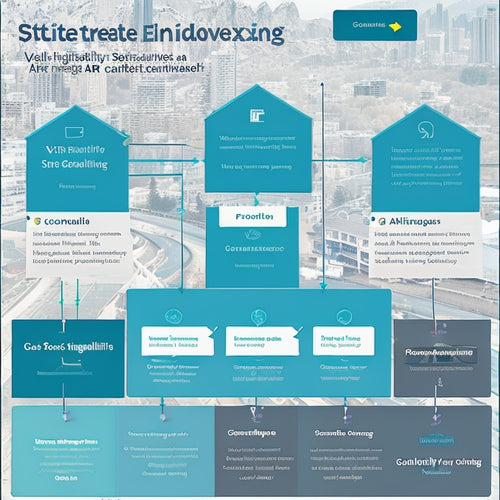
5 Best Digital Product Protection Strategies Online
Share
You can safeguard your digital products with five robust protection strategies. First, encrypt your files to guarantee they're inaccessible without the decryption key. Next, implement secure download methods, such as password-protected zip files or encrypted containers. Additionally, embed imperceptible watermarks or unique identifiers to track unauthorized usage. Limit access to your products with license keys, which authenticate purchases and prevent misuse. Finally, monitor for suspicious activity and track IP addresses to detect piracy. By exploring these strategies further, you'll uncover the details you need to secure your digital products remain secure and protected.
Key Takeaways
• Employ encryption to scramble data into an unreadable format, ensuring files are inaccessible without the decryption key.
• Use password-protected zip files or encrypted containers to prevent unauthorized access to digital products.
• Embed imperceptible watermarks or unique identifiers to track and trace unauthorized usage of digital products.
• Implement secure download managers with restrictions and consider HTTPS protocol for encrypted download processes.
• Utilize AI-powered tools for content monitoring and analyze user behavior patterns to detect piracy and unauthorized sharing.
Protecting Digital Files With Encryption
You can protect your digital files against unauthorized access by employing encryption, a powerful security measure that scrambles data into an unreadable format, making it inaccessible to anyone without the decryption key.
This robust security layer guarantees that even if your files are intercepted or accessed by unauthorized parties, they won't be able to read or exploit the data. Data encryption is particularly essential when sharing sensitive files with collaborators or clients.
By encrypting your files, you can ensure secure sharing, even when sending them over unsecured channels like email or messaging apps. When choosing an encryption method, consider using advanced algorithms like AES-256, which is virtually unbreakable.
Additionally, look for solutions that offer end-to-end encryption, guaranteeing that only the intended recipient can access the decrypted data. By encrypting your digital files, you're taking an important step in protecting your valuable assets and maintaining control over who can access them.
Implementing Secure Download Methods
When distributing digital products, implementing secure download methods is crucial to prevent unauthorized access and make certain that only authorized users can retrieve the files. You can't simply leave your digital products vulnerable to cyber threats and intellectual property theft.
To guarantee secure downloads, you should consider using password-protected zip files or encrypted containers. This way, even if an unauthorized user manages to access the download link, they won't be able to open the file without the correct password.
Another approach is to use a secure download manager that allows you to set expiration dates, limits the number of downloads, or restricts access to specific IP addresses. This gives you more control over who can access your digital products and for how long.
Additionally, consider using HTTPS protocol to encrypt the download process itself, making it harder for hackers to intercept and steal your files. By implementing these secure download methods, you can have peace of mind that your digital products are protected from unauthorized access and theft.
Using Watermarking and Fingerprinting
Digital product creators can also safeguard their intellectual property by embedding imperceptible watermarks or unique identifiers, known as fingerprints, directly into their digital files, making it possible to track and trace unauthorized usage. This strategy allows you to maintain copyright protection and brand visibility, even when your digital products are shared or distributed without permission.
By incorporating watermarks or fingerprints, you can identify the source of leaked or stolen content, and take legal action against perpetrators. Moreover, these hidden markers can help you monitor how your digital products are being used, providing valuable insights into user behavior and preferences. You can use this data to refine your marketing strategies, improve customer engagement, and increase revenue.
Additionally, watermarks and fingerprints can serve as a deterrent to potential pirates, as they know that their illegal activities can be traced back to them. By using watermarking and fingerprinting, you can effectively protect your digital assets and maintain a competitive edge in the market.
Limiting Access With License Keys
License keys, a widely adopted digital rights management (DRM) solution, restrict access to your digital products by requiring users to authenticate their purchases through unique identifiers, thereby preventing unauthorized use and validating that only legitimate customers can access your content.
By implementing license key generation, you can create a secure and controlled environment for your digital products. This involves generating a unique license key for each customer, which is tied to their specific purchase or subscription.
When a user attempts to access your digital product, the license key is verified to validate it matches the one issued. If it doesn't, access is denied, preventing unauthorized use.
You can also track unauthorized users by monitoring license key usage and identifying patterns of suspicious activity. This allows you to take swift action to revoke access and protect your intellectual property.
Monitoring for Unauthorized Sharing
You can further fortify your digital product protection by monitoring for unauthorized sharing, which involves tracking and analyzing user behavior to identify instances of piracy or illegal distribution. This proactive approach allows you to stay one step ahead of potential threats and take swift action to prevent revenue loss.
To effectively monitor for unauthorized sharing, consider the following strategies:
-
Tracking IP addresses: Identify suspicious activity by tracking IP addresses associated with multiple downloads or access requests
-
Utilizing content monitoring: Leverage AI-powered tools to scan for copyrighted content being shared illegally online
-
Analyzing user behavior patterns to detect anomalies that may indicate piracy
-
Implementing digital watermarking to trace the source of leaked content
-
Collaborating with online marketplaces and authorities to report and remove infringing content
Frequently Asked Questions
Can Digital Product Protection Strategies Be Used for Physical Products Too?
You can adapt digital product protection strategies for physical products by implementing security measures that safeguard intellectual property rights, utilizing encryption methods, and enforcing user authentication to prevent piracy and unauthorized access.
Are There Laws Regulating Digital Product Protection and Sharing?
As you navigate the digital landscape, beware of the legal quicksand - you're not immune to copyright infringement claims. You must understand the legal implications of digital product protection and sharing, lest you face costly lawsuits and reputational damage.
How Do I Balance Protection With User Experience and Convenience?
When implementing security measures, you're walking a fine line between protecting your digital products and preserving user experience. You'll need to strike a balance that guarantees seamless access while maintaining robust security, avoiding friction that might drive users away.
Can I Use Digital Product Protection for Free or Open-Source Products?
"Imagine giving away your life's work for free - that's what you're doing without protection! You can't fully secure open-source or free products, as open source limitations and free product challenges make them vulnerable to theft and exploitation."
What Are the Consequences of Failing to Protect Digital Products?
If you fail to protect your digital products, you'll face severe piracy consequences, including unauthorized access, leading to revenue loss and devastating brand reputation damage, ultimately crippling your business's bottom line and long-term success.
Related Posts
-

Top Digital Tools for Cost-Benefit Analysis
You're about to turbocharge your cost-benefit analysis with top digital tools that drive business growth. Begin with ...
-
Shopify SEO: A Simple Guide for Beginners
This article provides a comprehensive guide on Shopify SEO for beginners. It explores the benefits of implementing S...
-

What Are the Benefits of Sitemaps for SEO
Sitemaps play a crucial role in search engine optimization (SEO) by enhancing website visibility and improving ranki...

